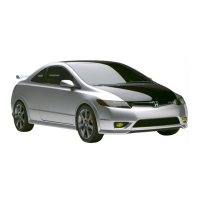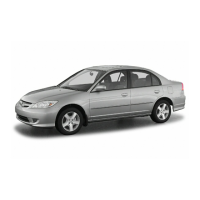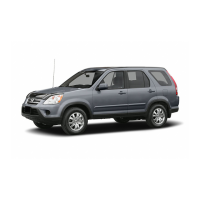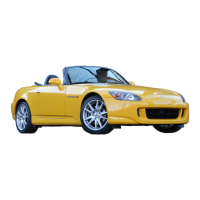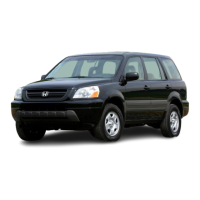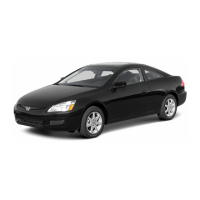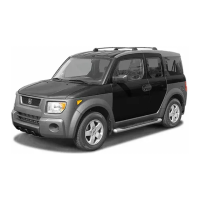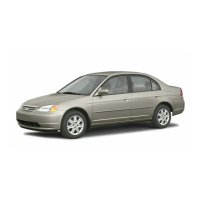
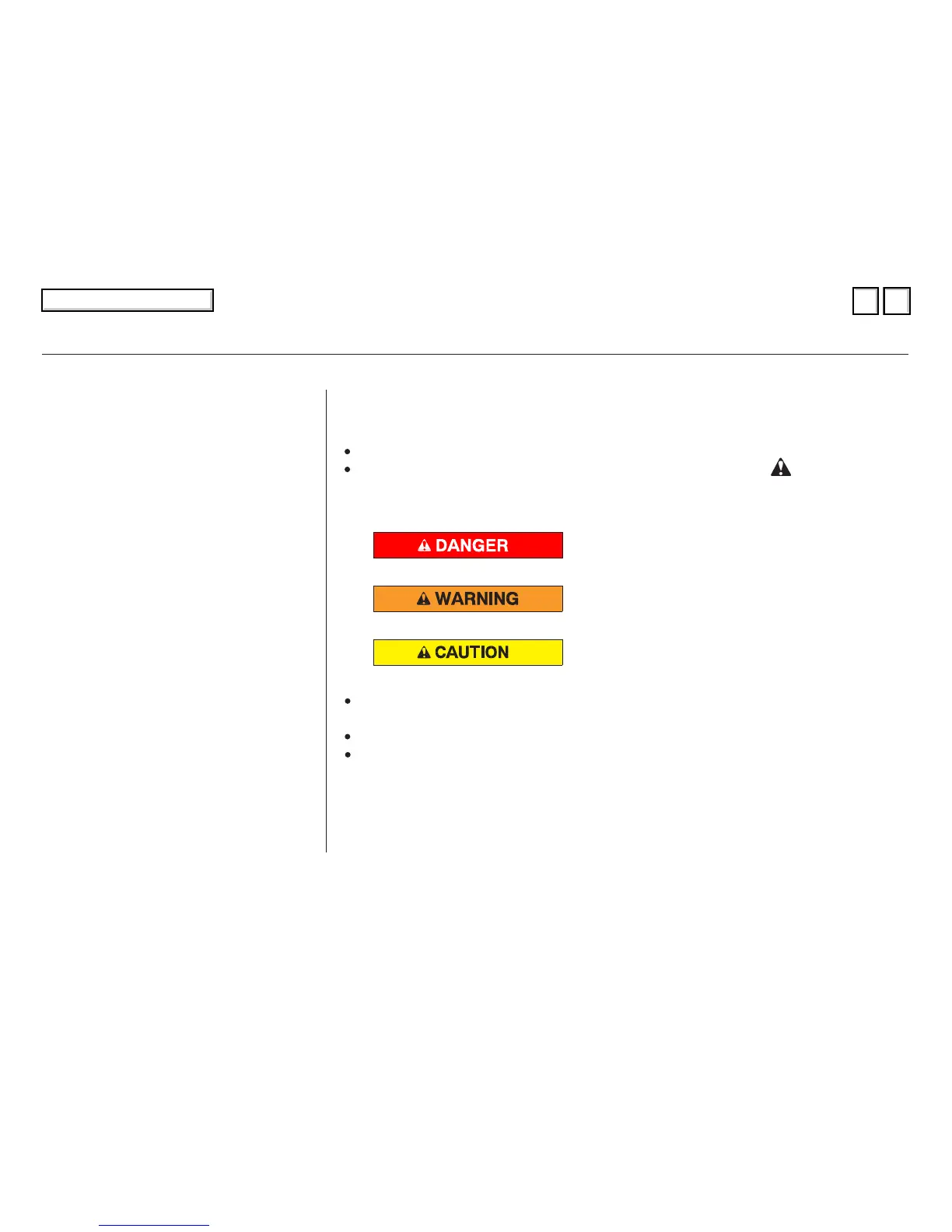 Loading...
Loading...
Do you have a question about the Honda 2005 Civic and is the answer not in the manual?
| Brand | Honda |
|---|---|
| Model | 2005 Civic |
| Category | Automobile |
| Language | English |
Warning about chemicals known to the State of California to cause cancer and birth defects or other reproductive harm.
Information about the vehicle being equipped with event data recorders or sensing and diagnostic modules.
Information about safety labels found on the vehicle.
Information about safety messages preceded by alert symbols and signal words like DANGER, WARNING, or CAUTION.
Details on safety headings like Important Safety Reminders or Important Safety Precautions.
Details on the 'Driver and Passenger Safety' section.
Instructions on how to use the vehicle correctly and safely.
Essential safety recommendations for protecting occupants and ensuring safe vehicle operation.
Explanation of the various safety features designed to protect occupants during a crash.
Guidance on properly protecting adult drivers and teenage passengers.
General guidelines for properly restraining infants, small children, and larger children in the vehicle.
Emphasizes the importance and proper use of seat belts for occupant protection in collisions.
Warns against the dangers of driving under the influence of alcohol.
Alerts users to potential hazards associated with airbag deployment and proper positioning.
Details requirements for properly restraining children of all ages in the vehicle.
Advises on the importance of controlling vehicle speed for safety and avoiding serious injuries.
Highlights the importance of regular maintenance for vehicle safety and preventing mechanical failures.
Details on the vehicle's seat belt system, including indicators and the importance of wearing them.
Explains the benefits and effectiveness of seat belts in preventing injury or death during a crash.
Description of the components that make up the vehicle's seat belt system.
Explanation of how the lap and shoulder belt are worn and fastened for proper restraint.
Details the various components of the vehicle's airbag system, including front and side airbags.
Describes how front airbags have two inflation stages that can ignite sequentially or simultaneously based on crash severity.
Explains how airbags have two deployment thresholds depending on whether the occupant is wearing a seat belt.
Details the automatic cutoff system for the passenger side airbag to reduce injury risk to children.
Emphasizes that all children must be properly restrained due to legal requirements and safety.
Recommends that children age 12 and under be properly restrained in a back seat for maximum safety.
Warns about the hazards of children in front seats due to forceful airbag inflation.
Safety advice for infants, especially regarding rear-facing child seats and front airbags.
Safety advice for small children, including forward-facing seats and front airbag risks.
Guidance for larger children on seat belt fit, booster seats, and risks from passenger front airbags.
Introduction to pages providing instructions on protecting drivers, adult passengers, and teenage children.
Instructions on how to close and lock vehicle doors to enhance safety during a crash.
Guidance on adjusting front seats for optimal driver control and passenger safety.
Instructions on adjusting seat-backs to an upright position for safety during airbag deployment.
Guidance on adjusting head restraints to protect occupants from whiplash and other crash injuries.
Detailed instructions on fastening seat belts correctly and positioning them for maximum protection.
Guidance on maintaining an upright sitting position with feet on the floor for safety during a crash.
Recommendations for pregnant women on wearing seat belts and maintaining a safe driving position.
Covers precautions like not sharing seat belts, avoiding accessories, and not placing objects between occupants and airbags.
Information on safely restraining infants in rear-facing child seats, emphasizing proper installation.
Details the types of child seats suitable for infants and the importance of rear-facing positions.
Guidance on the correct placement of rear-facing child seats in the back seat, away from front airbags.
Safety advice for small children, including forward-facing seats and front airbag risks.
Recommends placing forward-facing child seats in back seats, not the front, due to airbag hazards.
Describes suitable child seats for children aged one year or older, recommending five-point harness systems.
Guidance on choosing child seats, including conventional seats and LATCH-compatible options.
Provides step-by-step instructions for correctly installing child seats using LATCH or seat belts.
Step-by-step instructions for installing child seats using the LATCH system and lower anchors.
Instructions for installing child seats using the vehicle's seat belt system, including lockable retractors.
Instructions for installing child seats using a tether strap and anchor points for added security.
Provides questions to ask yourself to determine if a lap/shoulder belt properly fits a child.
Guidance on using booster seats until the lap/shoulder belt fits properly, and checking for safety standards.
Factors to consider when allowing larger children to ride in front, including physical size and maturity.
Discusses physical size requirements for proper seat belt fit, with or without a booster seat.
Considers a child's maturity and ability to follow rules as a factor for safe front seat riding.
Precautions regarding seat belt usage, such as avoiding neck placement and proper positioning.
Diagram illustrating the location of various controls within the vehicle's interior.
Diagram and explanation of the instrument panel for U.S. and Canadian models, detailing indicators and gauges.
Explains the meaning of various indicators on the instrument panel, including seat belt, airbag, and charging system warnings.
Describes the seat belt reminder indicator and beeper system for occupant safety.
Explains the SRS indicator for potential problems with airbags or seat belt tensioners.
Details the Side Airbag Off indicator and its meaning regarding passenger airbag status.
Explains the charging system indicator and what it means when the battery is not being charged.
Warns about the severe damage from low oil pressure and immediate action required.
Explains the malfunction indicator lamp for emissions control system problems and potential engine damage.
Explains the parking brake indicator and potential problems with the brake system.
Details the ABS indicator, its meaning, and when to have the vehicle checked by a dealer.
Explains the indicator for the vehicle's high beam headlights.
Describes the indicator for the Daytime Running Lights (DRL) system.
Explains the function of turn signal and hazard warning indicators for signaling and safety.
Describes the indicator that comes on when the cruise control is set.
Explains the immobilizer system indicator, its function, and what to do if the key is not recognized.
Indicates when the trunk lid is not closed tightly.
Serves as a reminder that the vehicle must be refueled soon.
Indicates when the windshield washer fluid level is low.
Informs the driver when scheduled maintenance is due and how to reset the indicator.
Explains the function and operation of the tachometer, speedometer, fuel, and temperature gauges.
Details how the odometer and trip meters track distance driven and how to reset them.
Shows the amount of fuel in the tank and provides a notice about driving with a low fuel level.
Explains the engine coolant temperature gauge and what to do if the pointer reaches the red mark.
Illustrates the location of controls on and around the steering wheel for easy access.
Instructions on operating windshield wipers in various modes and using the washer function.
Explains how to operate turn signals, headlights (low/high beams), and daytime running lights.
How to adjust the brightness of the instrument panel illumination for day and night.
Explains how to use the hazard warning lights (four-way flashers) for emergencies.
Instructions on operating the rear window defogger to clear fog, frost, and thin ice.
Steps for adjusting the steering wheel position for optimal driver comfort and control.
Information about master key, valet key, key number tag, and key care.
Explains how the immobilizer system protects the vehicle from theft and what to do if the key is not recognized.
Explains the four positions of the ignition switch (LOCK, ACCESSORY, ON, START) and their functions.
Explains how to lock and unlock doors using the lock tab and the driver's door handle.
Details how to operate power door locks using the driver's door lock tab, key, or master door lock switch.
Instructions on opening and closing the trunk lid.
Explains the function and use of the emergency trunk release lever for safety.
Details the functions of the remote transmitter buttons (UNLOCK, LOCK, PANIC) and their operation.
Instructions on how to replace the battery in the remote transmitter, including battery type and replacement steps.
Information on adjusting front seats for forward/backward movement and seat-back angle.
Explains how to adjust the height of the driver's seat using the dial on the seat cushion.
Instructions on how to access the rear seat by tilting and sliding the front seats.
Explains how head restraints protect against whiplash and how to adjust them for height and position.
Describes the console compartment lid that can be used as an armrest and how to operate it.
Instructions on how to fold down the rear seat-backs separately for cargo or access.
Instructions on operating power windows, including AUTO function and child safety lock.
Instructions on operating the moonroof for ventilation or sliding back, including tilt function.
Guidance on adjusting inside and outside mirrors for best visibility and using the inside mirror's day/night positions.
Steps for adjusting power mirrors using the selector and adjustment switches.
Explains how to use the power mirror heaters to remove fog and frost from the outside mirrors.
Instructions on how to apply and release the parking brake, and its indicator light.
Overview of interior convenience features like coat hooks, coin boxes, and power sockets.
Instructions on using and cleaning beverage holders, with warnings about hot liquids.
Details on opening and closing the console compartment lid for storage.
Instructions on opening and closing the glove box, with a warning about keeping it closed while driving.
How to use and close the coat hook, with a caution against using it for heavy items.
Instructions on opening and closing the center pocket lid.
Information on using the 12V DC accessory power socket and its limitations.
How to access the vanity mirror located on the back of the sun visor.
Details on operating ceiling lights, spotlights, and the ignition switch light.
Explains the three-position switch (ON, Door Activated, OFF) for the ceiling light.
Describes the ignition switch light that illuminates when the driver's door is opened.
Overview of the climate control system, including controls for airflow and temperature.
Explains fan control, temperature control, A/C button, recirculation, and mode control dial.
Instructions on operating the radio, selecting stations, and tuning.
Factors affecting radio reception, including distance, interference, and atmospheric conditions.
Instructions for playing CDs and MP3s, including loading, selecting tracks, and modes.
Guidance on handling CDs properly to prevent damage, skipping, and contamination.
Troubleshooting common error messages displayed by the CD player.
Troubleshooting common error messages displayed by the CD changer.
Instructions for playing tapes, including insertion, operation, and search functions.
Explains the anti-theft audio system and the process of entering the security code.
Step-by-step instructions for setting the vehicle's clock.
Information on using cruise control, including activation, speed adjustment, and cancellation.
Recommendations for driving during the first 600 miles (1,000 km) to ensure vehicle reliability.
Guidance on recommended unleaded gasoline types and octane ratings for optimal engine performance.
Steps for refueling the vehicle safely and properly at a service station.
Instructions on opening the fuel fill door, removing the cap, and stopping fuel flow.
Steps for safely opening and closing the vehicle's hood.
Instructions on how to check the engine oil level using the dipstick.
Guidance on checking the coolant level in the radiator reserve tank.
Tips for improving fuel economy through driving habits and vehicle maintenance.
Warnings and advice regarding installing accessories and modifying the vehicle.
Discusses the potential effects of modifications on vehicle handling, stability, and safety systems.
Information on using storage areas and the importance of proper cargo loading for safety.
Explains how to determine the vehicle's maximum load capacity and total weight limits.
Guidance on distributing cargo in the trunk and on a roof rack for safe weight distribution.
Information on using the cargo net to help secure items stored in the trunk.
Checklist of essential checks and adjustments to perform before driving the vehicle.
Tips for starting the engine under various conditions, including cold weather and altitudes.
Instructions on operating the manual transmission, including shift points and warnings.
Explanation of automatic transmission operation, including shift lever positions and shifting procedures.
Details on the continuously variable transmission (CVT), its operation, and maximum allowable speeds.
Guidance on parking the vehicle, including using the parking brake and parking tips.
Explanation of the braking system design, brake wear indicators, and application.
Information on how ABS works, important safety reminders, and its limitations.
States that the vehicle is not designed to tow a trailer, and attempting to do so voids warranties.
Safety precautions to follow when performing maintenance or service on the vehicle.
General safety advice for performing maintenance, including tool usage and hazard avoidance.
Guidelines for normal and severe driving conditions maintenance schedules and when to service the vehicle.
Criteria for selecting between normal and severe maintenance schedules based on driving conditions.
Information on where to get service, warranty requirements, and using Honda parts and fluids.
Items to check at specified intervals for basic maintenance, with instructions provided.
Diagrams showing the locations of essential vehicle fluids like engine oil, coolant, and brake fluid.
Instructions on how to check and add engine oil, recommending specific oil grades for optimal performance.
Specifies the recommended engine oil type, grade, and API certification for gasoline engines.
Details on changing engine oil and filter, including synthetic oil and additives.
Guidance on using synthetic motor oil that meets specific requirements and following change intervals.
States that the vehicle does not require oil additives, which may adversely affect performance.
Step-by-step instructions for changing engine oil and filter, requiring special tools and expertise.
Instructions on adding engine coolant, including warnings about hot engines and proper coolant types.
Steps for adding coolant to the reserve tank and radiator, emphasizing safety precautions.
Guidance on checking windshield washer fluid level, refilling, and cleaning wiper blades.
Instructions for checking and adding automatic transmission fluid, including fluid types and capacities.
Information on checking and adding manual transmission fluid, including recommended types.
Guidance on checking brake and clutch fluid levels and replacement recommendations.
Instructions on checking and adding power steering fluid, with warnings about steering wheel operation.
Details on the timing belt replacement intervals under normal and high-stress driving conditions.
Information on headlight aiming and replacing headlight bulbs.
Explains when headlight aiming adjustment may be required and who should perform it.
Step-by-step guide for replacing headlight bulbs, with warnings about handling hot bulbs.
Instructions for replacing front side marker, turn signal, and parking light bulbs.
Step-by-step guide for replacing rear bulbs, including stop/taillight, back-up, and turn signal lights.
Instructions for replacing the high-mount brake light bulb.
Guidance on cleaning seat belts using mild soap and water, avoiding harsh chemicals.
Instructions on cleaning floor mats and properly anchoring them.
Information on the dust and pollen filter, its replacement intervals, and when to have it serviced.
Guidance on checking wiper blade condition and replacing them.
Information on tire care, including inflation, inspection, and replacement.
Explains the importance of proper tire inflation for handling, tread life, and comfort.
How to inspect tires for damage, foreign objects, wear, and tread indicators.
Charts showing recommended cold tire pressures for normal and high-speed driving conditions.
Recommended cold tire pressures for standard driving conditions.
Recommended cold tire pressures for driving at speeds over 100 mph (160 km/h).
Importance of proper inflation and wheel alignment for decreasing tire wear.
Recommendations for rotating tires every 10,000 miles (16,000 km) to distribute wear evenly.
Guidance on replacing tires with the same size and construction, and replacing them in pairs.
Information on tire specifications, including wheel and tire sizes for different models.
Details tire sizes and specifications for various Honda Civic models and trims.
Advice on winter driving, including suitable tread designs and when to use snow tires or chains.
Recommendations for using snow tires for optimal performance in snowy or icy conditions.
Guidance on installing traction devices (tire chains), including warnings about clearance and contact.
How to check the battery's condition monthly using the test indicator and clean terminals.
Preparation steps for extended vehicle storage to prevent deterioration and ensure easy return to service.
Information on using the compact spare tire as a temporary replacement and its limitations.
Step-by-step instructions for safely changing a flat tire, including tool usage and safety precautions.
Troubleshooting guide for engine starting problems based on sounds or lack thereof.
Troubleshooting steps when the starter motor does not operate or operates slowly.
Precautions and steps for jump starting a vehicle with a dead battery, including safety warnings.
Immediate actions to take if the engine overheats, including checking for leaks and coolant levels.
Warns about the risks of low oil pressure and immediate actions to prevent engine damage.
Explains the charging system indicator and what to do if the battery is not being charged.
Explains the malfunction indicator lamp for emissions control system problems and potential engine damage.
Explains the brake system indicator, its function, and what to do if it comes on while driving.
Instructions for manually closing the moonroof if the electric motor fails.
Information on checking and replacing fuses, including fuse box locations.
Diagrams showing the locations of fuses in the interior and under-hood fuse boxes.
Guidance on professional towing services and acceptable towing methods.
Locations of vehicle identification numbers such as VIN, engine, and transmission numbers.
Key vehicle specifications including dimensions, weights, engine details, and fluid capacities.
Explanation of tire grading for treadwear, traction, and temperature performance.
Details on tire grading factors like treadwear, traction, and temperature ratings.
Explanation of the treadwear grade, a comparative rating based on tire wear rate.
Explanation of traction grades (AA, A, B, C) representing the tire's ability to stop on wet pavement.
Explanation of temperature grades (A, B, C) for tire heat resistance and dissipation.
Explanation of tire markings including size, load index, speed rating, and manufacturer identification.
Overview of vehicle emissions control systems and their importance for the environment.
Information on U.S. Clean Air Act standards for automobile emissions.
Explains the positive crankcase ventilation system's role in controlling engine emissions.
Describes the evaporative emissions control system's function in adsorbing and burning fuel vapors.
Explains the ORVR system's function in capturing fuel vapors during refueling.
Details the four systems that control exhaust emissions to minimize pollutants.
Explains the PGM-FI system's use of multiport fuel injection for engine control.
Describes how the ignition timing control system adjusts timing to reduce emissions.
Explains the EGR system's role in routing exhaust gas back to the intake manifold to reduce NOx.
Explains the function of the catalytic converter in converting exhaust gases into less harmful substances.
Recommends using Honda replacement parts or equivalents for repairs to maintain emissions levels.
Information on state emissions testing, readiness codes, and how to prepare the vehicle for testing.
Contact information for Honda customer service and advice on resolving dealership issues.
Details on information to provide when contacting customer service for assistance.
Overview of warranty coverages for new vehicle, seat belts, emissions, accessories, and replacement parts.
Covers defects in materials and workmanship for the new vehicle, excluding battery and accessories.
Provides warranty coverage for seat belts that fail to function properly for the vehicle's useful life.
Covers exterior body panels for rust-through from the inside for a specified period with no mileage limit.
Provides prorated coverage for replacement batteries purchased from the dealer.
Offers lifetime coverage for the muffler as long as the original purchaser owns the vehicle.
Covers emissions control systems, with coverage conditional on time, mileage, and specific factors.
Covers Honda Accessories, with limits depending on accessory type and other factors.
Covers Honda replacement parts against defects in materials and workmanship.
Provides up to 100 percent credit toward a replacement battery.
How to report vehicle defects that could cause crashes, injury, or death to NHTSA and Honda.
